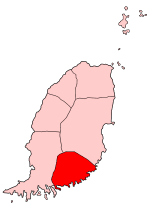Saint David Parish, Grenada
St. David Parish | |
|---|---|
Parish | |
| Nickname: The Virgin Parish | |
 | |
| Country | Grenada |
| Area | |
| • Total | 18 sq mi (47 km2) |
| Population | |
| • Total | 11,486 |
| • Density | 680/sq mi (261/km2) |
| ISO 3166 code | GD-02 |
Saint David in the southeastern part of Grenada is the fourth largest parish on the island. It is also the only one without a main town. Because of this fact, it is sometimes referred to as "The Virgin Parish". It is ringed by spectacular bays and inlets that help to provide the nation with a variety of small secluded beaches. With a rocky coastline that slopes up gently towards the central mountainous ridge, its beauty lies in its completely rural state.
History
A town called Megrin was established at St David’s Point in 1609 and destroyed during the 1795–96 Fedon conflict and the town never rebuilt. In the 1721 the catholic parish of Megrin was reopened by the French, but it was built down next to the sea. In 1747 Megrin in St David was one of the six churches and parishes in Grenada. In 1795 the Fedon Rebellion became a battle between Fedon and the English troops staying at the church over night. In Grenada lies the area of Perdmontempts which is a mountainous area which includes lots of valleys which bear rich fruit such as guava, cherries, plums, mangoes and sugar cane.
St. David's was also the home to the New Jewel Movement, which culminated in the Grenada Revolution March 13, 1979. Its founders, Theodore Victor, aka "Teddy", Sebastian Thomas, aka "Sambas", Unison White, economist, Wally Jeremiah, farmer, all discontented with the opposition party Grenada National Party, GNP, under Herbert Blaze, decided to build a grass roots movement that would organize and educate the Grenadian masses, publishing a weekly news paper called "The New Jewel".
St. David's become the hot bed of political activity in the late 1970s culminating in a confrontation with the Gary Regime over access to a popular beach LaSagess which had been bought by a British Lord, by the name of Lord Brownslow, denying natives access to the popular beach.
St. David's had served the same purpose for Eric Gairy some twenty years earlier when he returned from Aruba to stake his political future. Being funded by rich natives in the St. David's parish Gairy burned plantations and estates in what came to be known as "Sky Red" in a rebellion against British Rule, eventually leading to Grenada's independence in 1974.
St. David's is also the ancestral home of Malcolm X's mother.
Constituency
This section is empty. You can help by adding to it. (July 2010) |
External links
12°03′46″N 61°39′38″W / 12.06278°N 61.66056°W

